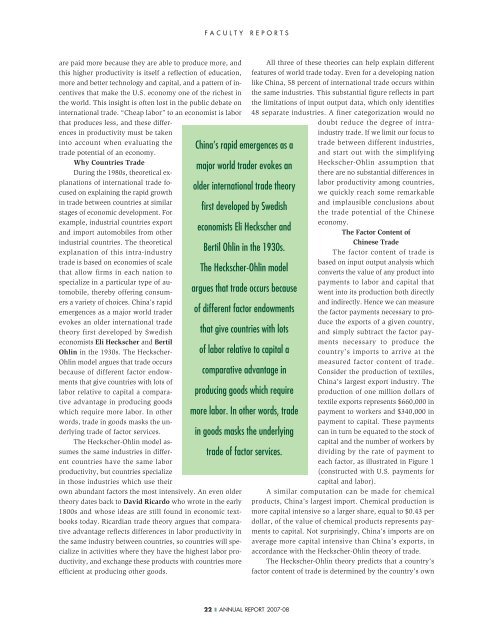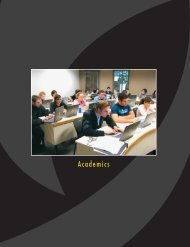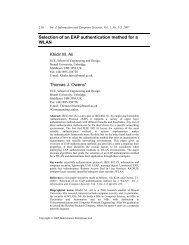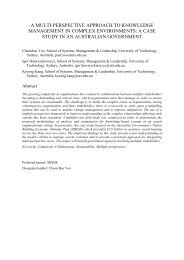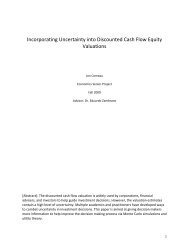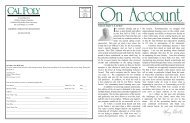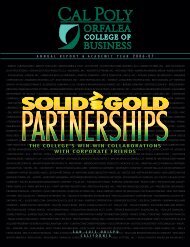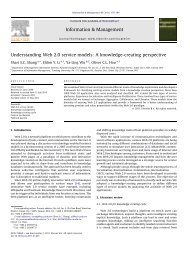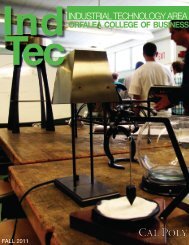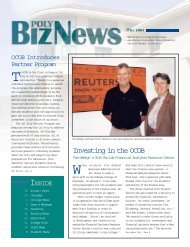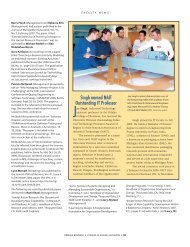OCOB Ann Rep 07-08 - Orfalea College of Business - Cal Poly San ...
OCOB Ann Rep 07-08 - Orfalea College of Business - Cal Poly San ...
OCOB Ann Rep 07-08 - Orfalea College of Business - Cal Poly San ...
Create successful ePaper yourself
Turn your PDF publications into a flip-book with our unique Google optimized e-Paper software.
FACULTY REPORTSare paid more because they are able to produce more, andthis higher productivity is itself a reflection <strong>of</strong> education,more and better technology and capital, and a pattern <strong>of</strong> incentivesthat make the U.S. economy one <strong>of</strong> the richest inthe world. This insight is <strong>of</strong>ten lost in the public debate oninternational trade. “Cheap labor” to an economist is laborthat produces less, and these differencesin productivity must be takeninto account when evaluating thetrade potential <strong>of</strong> an economy.Why Countries TradeDuring the 1980s, theoretical explanations<strong>of</strong> international trade focusedon explaining the rapid growthin trade between countries at similarstages <strong>of</strong> economic development. Forexample, industrial countries exportand import automobiles from otherindustrial countries. The theoreticalexplanation <strong>of</strong> this intra-industrytrade is based on economies <strong>of</strong> scalethat allow firms in each nation tospecialize in a particular type <strong>of</strong> automobile,thereby <strong>of</strong>fering consumersa variety <strong>of</strong> choices. China’s rapidemergences as a major world traderevokes an older international tradetheory first developed by Swedisheconomists Eli Heckscher and BertilOhlin in the 1930s. The Heckscher-Ohlin model argues that trade occursbecause <strong>of</strong> different factor endowmentsthat give countries with lots <strong>of</strong>labor relative to capital a comparativeadvantage in producing goodswhich require more labor. In otherwords, trade in goods masks the underlyingtrade <strong>of</strong> factor services.The Heckscher-Ohlin model assumesthe same industries in differentcountries have the same laborproductivity, but countries specializein those industries which use theirown abundant factors the most intensively. An even oldertheory dates back to David Ricardo who wrote in the early1800s and whose ideas are still found in economic textbookstoday. Ricardian trade theory argues that comparativeadvantage reflects differences in labor productivity inthe same industry between countries, so countries will specializein activities where they have the highest labor productivity,and exchange these products with countries moreefficient at producing other goods.China’s rapid emergences as amajor world trader evokes anolder international trade theoryfirst developed by Swedisheconomists Eli Heckscher andBertil Ohlin in the 1930s.The Heckscher-Ohlin modelargues that trade occurs because<strong>of</strong> different factor endowmentsthat give countries with lots<strong>of</strong> labor relative to capital acomparative advantage inproducing goods which requiremore labor. In other words, tradein goods masks the underlyingtrade <strong>of</strong> factor services.All three <strong>of</strong> these theories can help explain differentfeatures <strong>of</strong> world trade today. Even for a developing nationlike China, 58 percent <strong>of</strong> international trade occurs withinthe same industries. This substantial figure reflects in partthe limitations <strong>of</strong> input output data, which only identifies48 separate industries. A finer categorization would nodoubt reduce the degree <strong>of</strong> intraindustrytrade. If we limit our focus totrade between different industries,and start out with the simplifyingHeckscher-Ohlin assumption thatthere are no substantial differences inlabor productivity among countries,we quickly reach some remarkableand implausible conclusions aboutthe trade potential <strong>of</strong> the Chineseeconomy.The Factor Content <strong>of</strong>Chinese TradeThe factor content <strong>of</strong> trade isbased on input output analysis whichconverts the value <strong>of</strong> any product intopayments to labor and capital thatwent into its production both directlyand indirectly. Hence we can measurethe factor payments necessary to producethe exports <strong>of</strong> a given country,and simply subtract the factor paymentsnecessary to produce thecountry’s imports to arrive at themeasured factor content <strong>of</strong> trade.Consider the production <strong>of</strong> textiles,China’s largest export industry. Theproduction <strong>of</strong> one million dollars <strong>of</strong>textile exports represents $660,000 inpayment to workers and $340,000 inpayment to capital. These paymentscan in turn be equated to the stock <strong>of</strong>capital and the number <strong>of</strong> workers bydividing by the rate <strong>of</strong> payment toeach factor, as illustrated in Figure 1(constructed with U.S. payments forcapital and labor).A similar computation can be made for chemicalproducts, China’s largest import. Chemical production ismore capital intensive so a larger share, equal to $0.43 perdollar, <strong>of</strong> the value <strong>of</strong> chemical products represents paymentsto capital. Not surprisingly, China’s imports are onaverage more capital intensive than China’s exports, inaccordance with the Heckscher-Ohlin theory <strong>of</strong> trade.The Heckscher-Ohlin theory predicts that a country’sfactor content <strong>of</strong> trade is determined by the country’s own22 ❚ ANNUAL REPORT 20<strong>07</strong>-<strong>08</strong>


